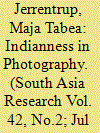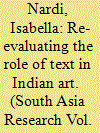| Srl | Item |
| 1 |
ID:
185179


|
|
|
|
|
| Summary/Abstract |
This article explores the question whether there is a specifically Indian style of photography. A survey of photography students from various institutions revealed that though there is little clarity about the actual look of an Indian style of photography, students clearly define their own photographs as Indian. Intriguingly, the focus is less on certain visual characteristics, but more on the feelings they derive from the photographs, a scenario which is reminiscent of the rasa theory. Even though this was hardly mentioned by the students, this psycho-social element seems to have left a cultural imprint but also reflects an act of claiming ownership and agency. In addition, the students identified alienating aspects in photography, such as seeing one’s own culture like an outsider, but at the same time consider it to be integrating, since photography paves the way for a deeper engagement with one’s own culture, and as such strengthens Indianness.
|
|
|
|
|
|
|
|
|
|
|
|
|
|
|
|
| 2 |
ID:
091722


|
|
|
|
|
| Publication |
2009.
|
| Summary/Abstract |
This article seeks to rediscover and contemporise the importance of using the shastras, Sanskrit technical treatises, as a standard of critique to analyse Indian art. The applicability and interpretative value of this approach for the study of Indian art history is exemplified by a case study of the miniature paintings representing the image of Shri Nathji in Nathdvara. Analysing the image of Shri Nathji as it appears in Nathdvara miniature paintings from different shastric points of views, including the theories of measurement and proportion, postures, mudras and rasa theory, the article proposes to include in the definition of shastra not only canonical textual sources but also practical/visual and oral/verbal transmitted knowledge. While textual concepts are used as a methodology for the reading of the image of Shri Nathji, the canonical shastric theories are considered side by side with such oral and practical knowledge in an attempt to redefine the concept of 'text' for Indian tradition, and especially to further our knowledge on the relationship between text and image in Indian art.
|
|
|
|
|
|
|
|
|
|
|
|
|
|
|
|